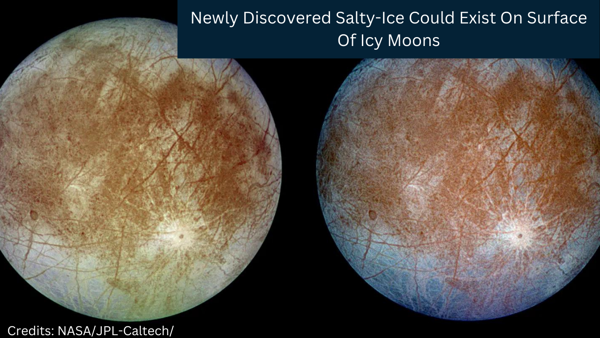
Science & Space
New Form Of Nacl: Scientists Discovered New Form Of Salty-Ice That Could Exist On Surface Of Icy Extra-terrestrial Moons, Europa In Particular
Europa is one of the solar system's most enigmatic moons, and scientists are skeptical of it due to the presence of liquid water and ice. Because of the presence of liquid water and ice, science fiction provided a hypothetical scenario: What if alien life was or is thriving in an ocean beneath Jupiter's moon Europa's icy surface?
Recently, scientists discovered something amusing about this moon's crisscross red strikes, which resemble a scar on the moon's face. A scientific team led by the University of Washington believes it is a frozen mixture of water and salts, but its chemical signature is enigmatic because it matches no known substance on Earth.
However, the team believes that they may have solved something extraordinary about the chemical substance or mixture of slats that are present on Jupiter's moon, Euroa. The puzzle was all about the discovery of a new type of solid crystal that forms when water and table salt combine in cold and high-pressure conditions.
According to researchers, they have created the same substance found on the moon. They artificially created the new substance in the lab that could form at the surface and bottom of these worlds' deep oceans.
The study, which was published in the Proceedings of the National Academy of Sciences on February 20th, announces a new combination for two of the most common substances on Earth: water and sodium chloride, or table salt.
Unusual salt molecule:
Salt and water are plentiful on Earth, but only in their natural state. Europa, the alien moon, contains the same salt and water as Earth, but in a more exotic form. To create that type of salt artificially, scientists used the same technique that people used in the 1800s, but at high pressure and low temperature.
At very cold temperatures, the salt and ice combined to each other to form a rigid salted icy lattice, known as a hydrate, held in place by hydrogen bonds. The simplest form of hydrate found on Earth consists of one salt molecule for every two water molecules.
But, during the experiment, the team discovered two distinct hydrates at moderate pressures and low temperatures that are strikingly different. The first contains two sodium chlorides for every 17 water molecules, while the second contains one sodium chloride for every 13 water molecules. This would explain why the signatures from Jupiter's moons' surfaces are more "watery" than expected. As a result, Europa's albedo is 0.64, which is quite high when compared to Earth's 0.30.
According to lead author Baptiste Journaux, a UW acting assistant professor of Earth and space sciences, the discovery of new types of salty ice is important not only for planetary science but also for physical chemistry and even energy research, which uses hydrates for energy storage.
The Experiment:
The experiment involved compressing a small amount of salty water between two diamonds the size of a grain of sand, squeezing the liquid up to 25,000 times the standard atmospheric pressure. The transparent diamonds enabled the team to observe the process under a microscope.
Scientists believe that creating such conditions in Europa is very common due to Europa's environment and architecture, but creating such an environment in the lab is quite difficult. Five to ten kilometers of ice, according to scientists, would cover oceans hundreds of kilometers thick, with even denser ice possible at the bottom.
According to the scientific team, to create such hydrate molecules scientists needed to create an environment of minus 50 degrees of centigrade, and after that, the stability of the salt stays. Such kind of environment is only available in lakes in Antarctica.
Scientists are trying to create a handsome amount of salt to elaborate and increase their research volume to get a definite result. However, NASA and other agencies are preparing to launch satellites to explore these watery moons' architecture in detail.
Upcoming missions to the water worlds:
NASA and European Space Agencies' missions will explore Europa and other icy moons of Jupiter and Saturn. To examine Europa in detail, NASA is expected to launch its "Europa Clipper" in 2024. In 2026, NASA will launch its "Dragonfly Mission" to Saturn's moon Titan which is also one of mystery for scientists.
ESA's Jupiter Icy Moons Explorer, Juice, will also conduct detailed observations of the giant gas planet and its three large ocean-bearing moons, Ganymede, Callisto, and Europa, using a suite of remote sensing instruments.
Therefore, new mysteries about water moons and gas giants will be revealed to the world. Water moons are crucial in this case because humans are looking for life and the possibility of relocating species to conduct experiments.

0 Comments